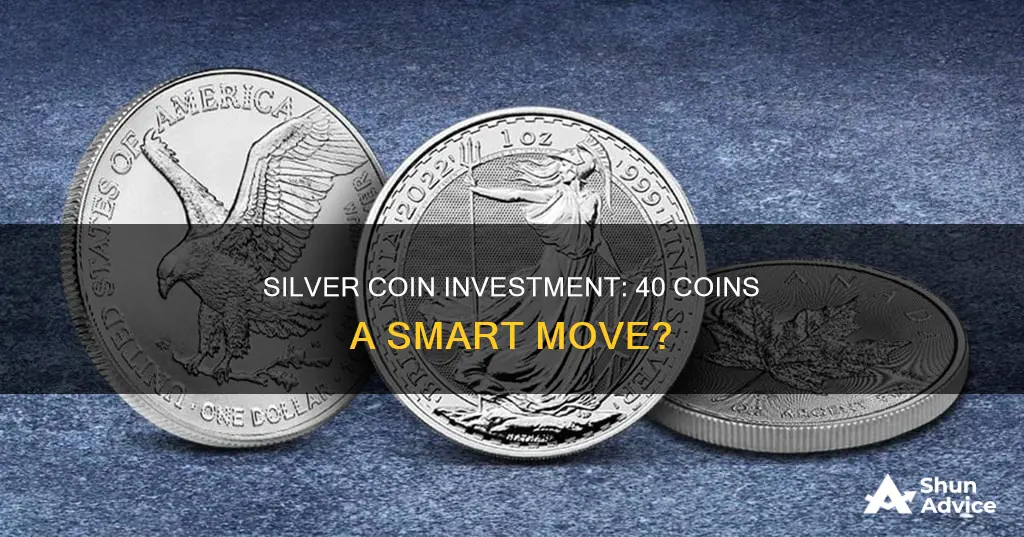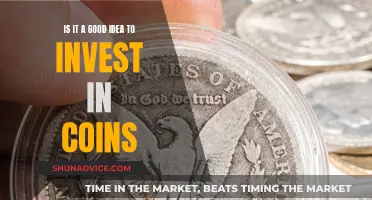
Silver investments are a great way to diversify your portfolio and protect your wealth from the volatile ups and downs of the stock, bond, and currency markets. Silver is a critical industrial commodity with unparalleled utility, and its price is far less costly per ounce than other precious metals, making it an attractive investment option.
One particular type of silver investment that has gained popularity is junk silver, which refers to circulated silver coins with no value beyond their silver content. These coins, which include pre-1965 American coins and Canadian silver coins, are typically 90% silver and are valued for their bullion content.
Within the category of junk silver, 40% silver coins occupy a unique position. Following silver supply shortages in the early 1960s, the United States transitioned from using fine silver in circulating coins to an alloy with reduced silver content, known as 40% silver. This period, from 1965 to 1970, produced highly desirable and collectible coins, including the Kennedy Half Dollar and the Eisenhower Dollar.
So, are 40 silver coins a good investment? The answer is yes. 40% silver coins offer investors a way to acquire silver bullion at a relatively low cost. They are easy to transport, liquidate, and are accepted by most silver buyers. Additionally, they have potential numismatic and collector value, with certain coins reaching high premiums due to their rarity or historical significance.
However, it's important to consider the risks associated with any investment, including variations in silver content, authenticity verification, and potential premiums and fees. Nonetheless, 40% silver coins present a compelling opportunity for those looking to diversify their portfolios and take advantage of silver's intrinsic value.
What You'll Learn

Silver coins are a good investment during economic downturns
Secondly, silver is an effective hedge against inflation and market volatility. Silver is often used to diversify investment portfolios, protecting against inflation and the ups and downs of the stock, bond, and currency markets. Silver's price tends to rise when interest rates fall behind the rising cost of living, making it a good defence against inflation.
Thirdly, silver is easily accessible and liquid. Silver coins, in particular, are highly liquid and can be transported discreetly. They are also easy to sell, as they are widely recognised and accepted by most silver buyers.
Additionally, silver coins are a good investment because they have a face value that is typically lower than their intrinsic metal value. This means that even if the market price of silver drops, the coins will still hold some value as currency.
Finally, silver is a good investment during economic downturns because its price tends to be more volatile than gold. While this makes it a riskier investment, it also offers greater potential for short-term profits.
In conclusion, silver coins are a good investment during economic downturns due to their historical value as a precious metal, their role in industrial applications, their effectiveness as a hedge against inflation, their liquidity and accessibility, their face value, and their potential for short-term gains.
Elon Musk's Bitcoin Strategy: Why Invest?
You may want to see also

Silver is a critical industrial commodity
Silver is a white metal that is easy to process and is chemically inert, reacting with very few substances, such as sulfur and sulfur derivatives. It is used almost exclusively as an alloy with copper, as pure silver is too soft. Silver does not change colour when mixed with copper.
Silver is a rare metal, even rarer than gold in its pure form. It is often found alongside other base metals, and around 70% of silver production occurs during the extraction of copper, lead and zinc. In nature, silver ores are frequently permeated by lead ores. As a result, only around 20,000 tonnes of silver are obtained each year.
Silver has a long history of use by humans. It has been known since the 5th millennium BC and was used as money in the 6th century BC. The Greeks produced the first silver coins, and until the 20th century, silver was more important than gold.
Today, silver is produced in many countries, including Mexico, Peru, Australia, China, Poland, Russia, Canada and the USA. The most important trading venues for silver are the New York Mercantile Exchange (COMEX), the Tokyo Commodity Exchange, the Chicago Board of Trade and the London Bullion Market. Silver is a valuable investment due to its affordability and diversification potential.
The Ultimate Guide to Making Money with Bitcoin
You may want to see also

Silver is a good investment for new collectors
Another advantage of silver is its affordability and accessibility. Silver coins, also known as "junk silver", are widely available from mints, distributors, and even banks. These coins are typically circulated pre-1965 American coins with 90% silver content, although some contain 40% silver. While these coins may not have significant numismatic value, their silver content makes them intrinsically valuable.
For new collectors, junk silver offers an easy way to build an initial portfolio of silver without breaking the bank. The silver content of these coins is standardized, making them highly divisible and versatile. They can be traded for other products or sold to fund higher-end investments. Additionally, junk silver is easy to transport, liquidate, and is accepted by most silver buyers.
It's important to note that the value of silver, like any investment, can fluctuate. Market demand, supply, and economic factors all influence silver prices. However, silver has historically provided a safe haven during rocky economic times, and its value tends to increase during periods of economic anxiety.
In summary, silver is a good investment for new collectors due to its affordability, accessibility, and intrinsic value. Junk silver coins provide an excellent entry point into the world of precious metal investing, offering a stable and versatile option for those looking to diversify their portfolios.
Dogecoin: Losing More Than You Invested?
You may want to see also

Silver is easy to liquidate
The most commonly recognised silver products are the easiest to liquidate. These include silver coins such as the American Eagle and Canadian Maple Leaf. These coins are easy to transport and can be liquidated quickly. They are also accepted by virtually any silver buyer and are a good hedge against inflation.
Silver bullion bars are another option for investors. These bars can be purchased in various sizes, from 100-ounce bars to 1,000-ounce bars, and are easy to store and transport. However, it is important to note that silver bullion bars may require an assay to verify their weight and fineness if they have been kept in an investor's personal possession. This can add time and cost to the liquidation process.
Overall, silver is a highly liquid asset that can be easily converted to cash or other assets. It is a good option for investors looking for a flexible and efficient way to diversify their portfolios.
A Beginner's Guide to Investing in Bitcoin on Robinhood
You may want to see also

Silver is a good hedge against inflation
Silver is a precious metal that has been recognised as a critical industrial commodity with unparalleled utility. It is highly valued for its electrical applications, as it is the best conductor of heat and electricity. Silver is also used in electronics, automobiles, mirrors, water purifiers, and solar panels.
Silver's value is tied to its industrial demand, which is expected to grow with the transition to clean energy. This makes silver a good hedge against inflation as its value is influenced by rising consumer prices and economic growth.
Silver has historically served as an effective hedge against inflation over very long periods. Since 1915, the inflation-adjusted price of silver has risen by more than 40%. While silver is subject to price volatility, it can provide a cushion against declines in purchasing power over the long term.
Additionally, silver is often viewed as a "safe-haven" investment, similar to gold. It can help investors preserve their wealth and stabilise their portfolio during times of economic turmoil and stock market declines.
Silver is also a good investment option due to its affordability compared to gold. Its lower price per ounce allows investors to purchase larger quantities with the same investment dollars.
Furthermore, silver coins, such as the iconic Kennedy Half Dollar and the Eisenhower Dollar, are highly desirable collectibles and a great choice for investment. These coins, minted between 1965 and 1970, contain about 40% silver and are easy to recognise, transport, and liquidate.
Overall, silver is a good hedge against inflation due to its industrial demand, historical performance, safe-haven status, affordability, and the collectibility of certain silver coins.
Strategic Bitcoin Investments: Making Profits with Crypto
You may want to see also
Frequently asked questions
40% silver coins are coins that contain 40% silver and 60% of another alloy, usually copper.
The term "junk silver" is used to describe American coins that circulated before 1965. These coins are not considered to have any numismatic value and are only worth their weight in silver.
Yes, 40% silver coins are a good investment because they are highly liquid, easy to transport, and have low buyer's premiums. They are also a good hedge against inflation. Additionally, their value is closely tied to the spot price of silver, which can be advantageous during economic uncertainty.
Two of the most iconic 40% silver coins in U.S. history are the Kennedy Half Dollar and the Eisenhower Dollar. These coins were minted between 1965 and 1970 and are highly sought-after by collectors.
You can purchase 40% silver coins from local precious metals and coin dealers, such as AU Precious Metals, or online through websites like JM Bullion and Hero Bullion.







